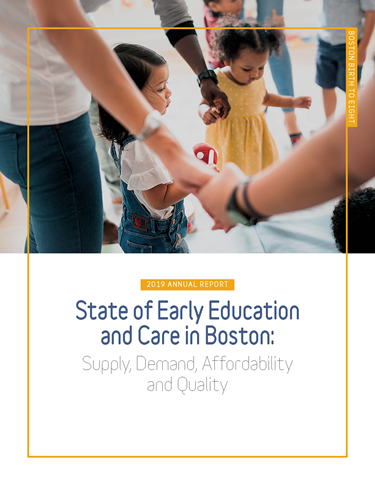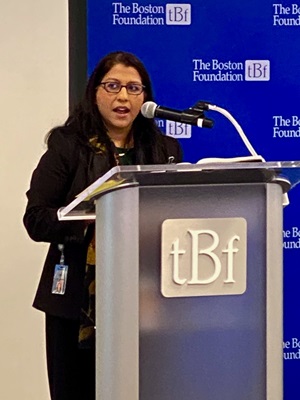Bridging Boston's early education gaps will take new partnerships, better data
The first-ever Boston Opportunity Agenda report on early ed sparks a robust conversation
November 7, 2019
By Sandy Kendall, Senior Communications Manager
You remember what they say about an ounce of prevention? It’s worth a pound of cure. That holds true in the realm of early childhood care and education, too. Nobel laureate economist James Heckman has specifically calculated that equation: Every $1 spent on early childhood care saves or prevents spending $13 later on cures in the shape of subsidized health care, government assistance or incarceration.
It is that dramatic. But while our understanding of the importance of early care has only grown in recent years, it hasn’t been matched by an understanding of what the landscape looks like for parents and caregivers seeking affordable, quality care for children under age 5. Add the economic pressures – the cost of care, the need for care for working parents – and you have a critical need for answers to a wide variety of questions. How does the number of infants and toddlers in each Boston neighborhood align with the care available? Is that care high quality? Is it affordable? Those and more unanswered questions led the Boston Opportunity Agenda and key partners to undertake their first-ever landscape analysis of the field in Boston, resulting in a report released on November 5, 2019, called State of Early Education and Care in Boston: Supply, Demand, Affordability and Quality.
At a forum around its release at the Boston Foundation, co-author Pratima Patil presented the findings of what is anticipated to be an annual report. In (very) brief: Researchers identified significant gaps in access, in quality and in affordability of child care (a year of infant care exceeds a year at UMass) across the city. Like so many other challenges, though, these gaps hit women and people with lower incomes hardest. Breaking down availability and affordability by neighborhood found, unsurprisingly, these challenges are also much more pronounced in historically black or Latino neighborhoods.
The research also highlighted a number of unanswered questions. The researchers melded data from numerous sources collected in different ways, and this inaugural report is a huge first step and important launch pad for discussion. The authors themselves are first to point out, however, that the other big gap in early childhood education and care is in data itself. What are the best measures of quality (since the report used voluntary state and local certifications that leave out many small providers)? How do we factor in families not seeking care, or workers from outside the city seeking care close to the office?
This point was echoed throughout the panel discussion that followed Patil’s presentation, representing a stellar array of stakeholders. The panel, moderated by Boston Opportunity Agenda Executive Director Kristin McSwain, included:
- Samantha Aigner-Treworgy, Commissioner, Mass Department of Early Education and Care
- Tania Del Rio, Executive Director, Mayor’s Office of Women’s Advancement
- Justin Pasquariello, Executive Director, East Boston Social Centers
- Sarah Savage, Senior Policy Analyst & Advisor, Regional and Community Outreach, Federal Reserve Bank of Boston
- Michael Yogman, Chair, Child Mental Health Task Force Mass Chapter, American Academy of Pediatrics
Panel members came at the issues from varied backgrounds: medicine, business, care provider, city and state government, but they largely agreed on some fundamental truths. Chief among them were elaborations on a dynamic that Patil had raised in her presentation: There’s a distinct link between stable, high-quality child care and a strong economy. Parents confident in their children’s situation are less apt to have irregular attendance at work, drop out of school or professional development opportunities, reduce to part time, or generally reduce their contribution to the economy as both earners and spenders. Child-care workers in better-compensated settings are more apt to stay in the field, develop long-term relationships and continue a cycle of nurturing that leads to more healthy adults who in turn contribute fully to society and economy.
Making this lens part of the public discussion is key. As Del Rio said, “What I’d like to amplify about this report is the fact that it exists. We have families in Boston—and nationally—framing the child-care problem as a private thing and experiencing it in silence. This report helps start public conversation, covering also the child-care workforce. The women doing this low-paying job are propping up the rest of the economy.”
Commissioner Aigner-Treworgy, having recently served in a similar role in Chicago, confirmed the broader challenge. “We need to address this at a systems level… by financing structures that allow or incentivize community agencies with livable wages, or addressing regulations that make it unviable [for someone] to open an infant and toddler room.” The Commissioner, who started in Massachusetts this summer, suggested taking a cue from the K–12 world and considering an entire site and not just the teachers as important elements of a child’s experience and, especially, incentivizing and supporting family child-care centers as small businesses. “These are challenges for Massachusetts but also nationally: How do we take what we know is possible and operationalize that at scale for the 9,000 centers we’d need to meet real needs of our communities?”
Improving data collection is one step. Partnership is another. In his closing remarks from Titus DosRemedios, Director of Research and Policy at Strategies for Children, highlighted partnerships and collaboration as keys to getting early childhood caught up with the K–12 space. That means state funding, business backing, innovation from all sides, and the power and advocacy of the people in the room.


